Villarrica Volcano Hike: My Experience Climbing Chile’s Iconic Active Volcano

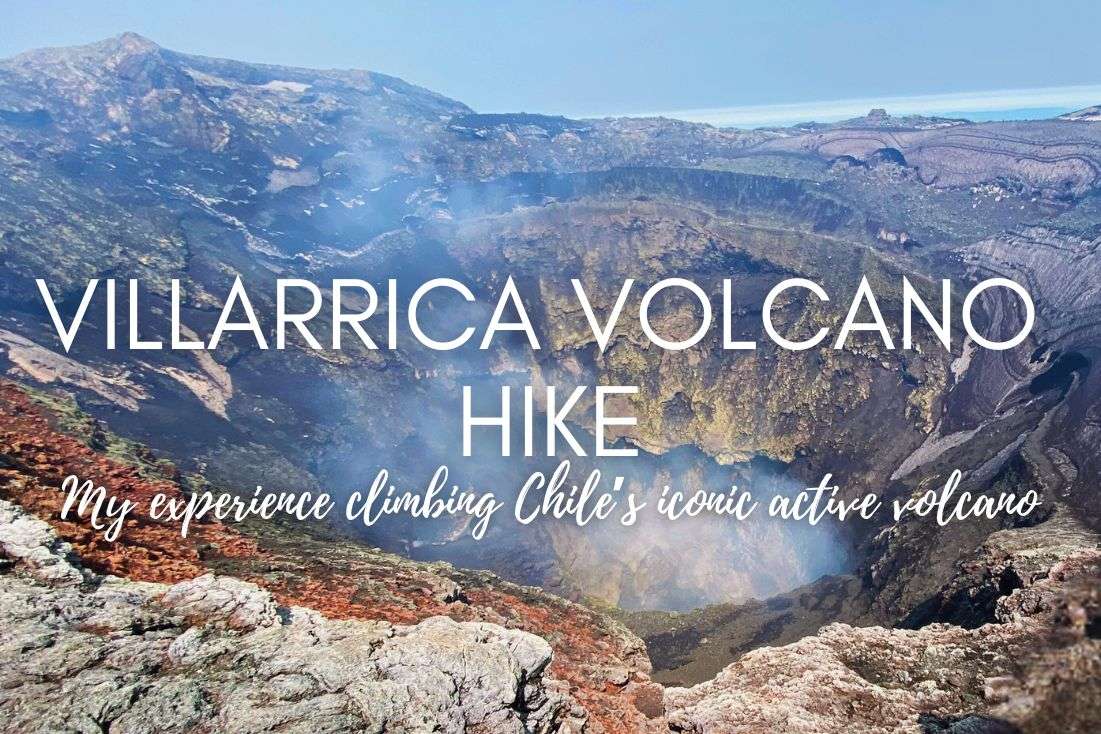
The Villarrica Volcano hike is one of the most iconic experiences in Chile. As one of the most active volcanoes in the world, Villarrica offers breathtaking views and a very tough climb to its summit.
How was my ascent experience? Was it dangerous? The short answer is: Climbing Villarrica Volcano was the toughest, most challenging trek I’ve ever been on! It was a soul-moving experience, and I would do it again, no question. Pricey? Yes. Challenging? YES. Rewarding? 100 %.
How did I prepare for it, and should you attempt it too? In this article, I’ll share my personal experience, essential tips, and everything you need to know to decide if this incredible adventure is right for you.
Learn more about traveling in Chile.
What makes Villarrica Volcano special?
Villarrica is a stratovolcano that rises 2,847 m (9,340 ft) above sea level, towering majestically towering majestically near the shores of Lake Villarrica in the heart of Chile’s Lake District. It’s renowned for being one of the few volcanoes in the world with a persistent lava lake, offering adventurers a rare and exhilarating experience.
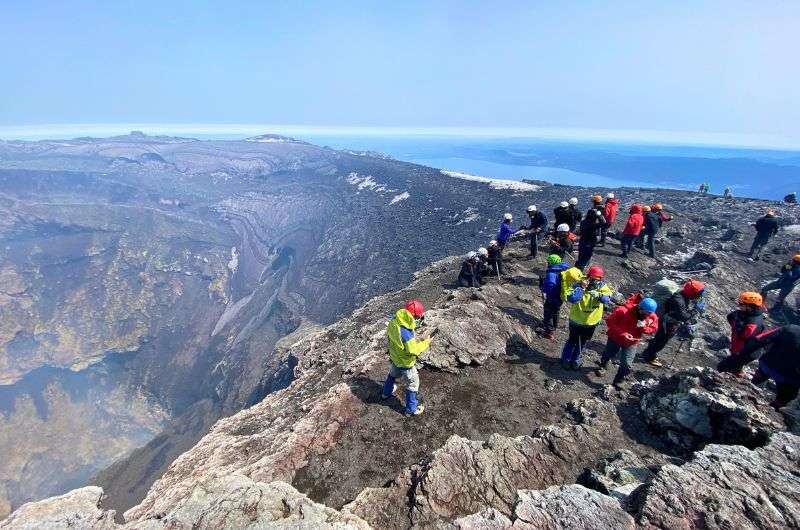
Home of the great spirit. I couldn't agree more
The Mapuche people, the last independent Indigenous tribe in Chile, call Villarrica “Rucapillán,” meaning “home of the great spirit.” After climbing it, I can attest that this volcano feels alive!
Quick facts and stats about Villarrica Volcano
- Villarrica is a stratovolcano with a height of 2,847 m (9,340 ft).
- Its large elliptical caldera measures 6.5 and 4.2 km in diameter (4 and 2.61 mi).
- The last eruption was in 2015.
Is the Villarrica Volcano Hike worth it?
Climbing Villarrica Volcano is one of the most exhilarating experiences in South America. It’s challenging, rewarding, and offers a rare chance to stand on the edge of an active volcano. While it’s not for everyone, those who take on the challenge will be rewarded with unforgettable memories and a deep appreciation for the raw power of nature. Would I do it again? In a heartbeat. If you’re considering the Villarrica Volcano hike, my advice is simple: go for it. Just be prepared for an adventure you’ll be talking about for years
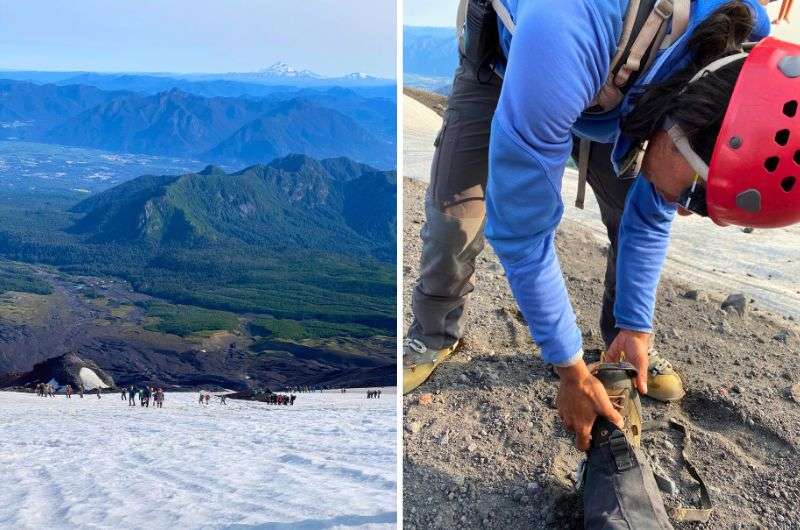
But you can't do it without the proper gear. This hike is hardcore
Villarrica Volcano hike details:
- Distance: 8–10 km (5–6 miles) round trip, depending on whether you use the ski lift.
- Elevation gain: Roughly 1,400 m (4,593 ft) from the base (around 1,400 m or 4,593 ft above sea level) to the summit at 2,847 m (9,340 ft).
- Hiking time: The ascent takes around 3–4 hours, and the descent is 1.5 hours (on a sled!)
- Difficulty: Very hard
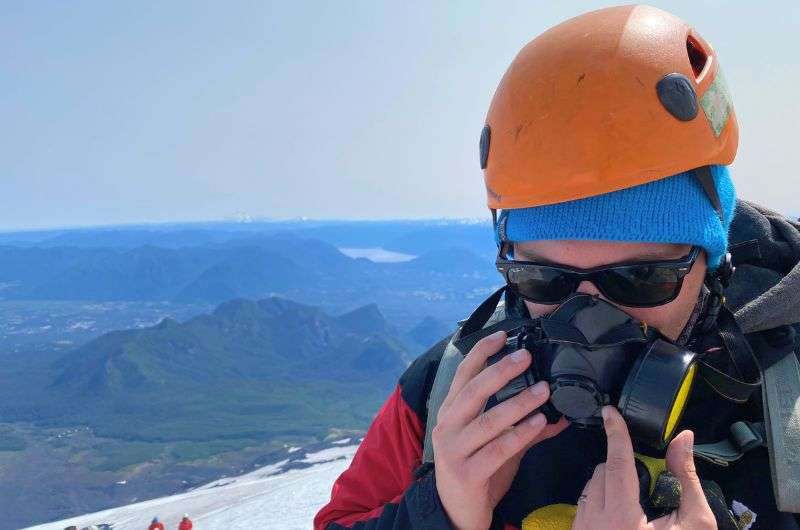
My trusty oxygen mask helped me fight the fumes
My top tips for climbing Villarrica Volcano
- Best months to go: High season runs from December to February, offering the best weather conditions and availability of guided tours. Guided tours are not available outside these months.
- Villarrica is free to climb year-round if you’re a professional climber and you secure the CONAF permit.
- Look for tour companies in Pucón—don’t waste your time booking online and decide on the spot after you’ve asked around. There is always availability, even in high season.
- Don’t forget your sunglasses, sunscreen, and lip balm. The conditions on your way up won’t spare you.
- The price of a Villarrica Volcano guided tour is anywhere from CLP 130,000 to CLP 150,000 (USD 130 to 150), including gear, backpacks, and snacks.
- Don’t overestimate yourself, this is not a suitable trek for your first mountaineering experience. That said, the guides are used to different levels of experience and stamina and will cheer you on if you're stuck in the back of the group.
- And the most important thing, of course, don’t forget to fully charge your cellphone and make enough space in it for tons of photos and selfies!
- Where to stay: My top hotel picks are Hotel Antumalal in Pucon and Hotel Cumbres Puerto Varas for easy access to attractions in the Lake District.
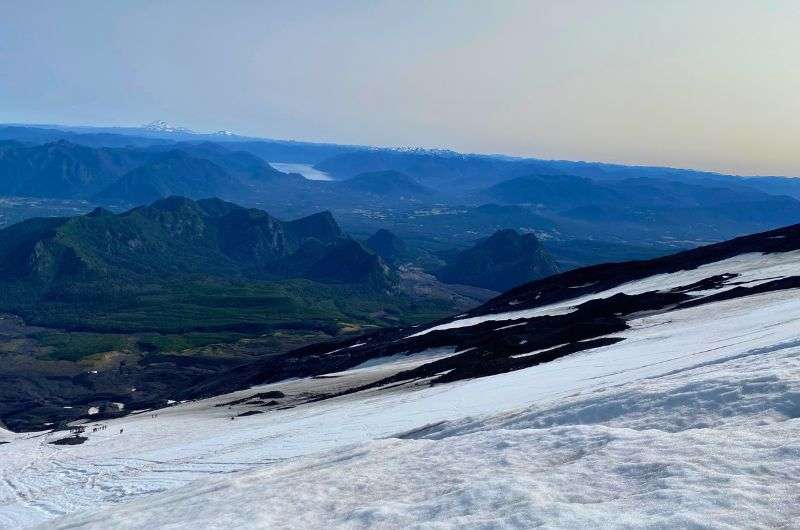
The summer months are the only time you can book the Villarrica Volcano hike tour
Preparing for the Villarrica Volcano Hike
Choosing the right tour company
Most people climb Villarrica with a guided tour, and for good reason. Guided tour prices start around CLP 130,000 (USD 130), which includes all necessary gear, snacks, and the expertise of certified guides.
While I initially booked my tour online, I learned the hard way that booking in person in Pucón is usually cheaper and more reliable. Agencies in town often offer last-minute availability, even during peak season. And this way, they won't forget about your online booking like in my case. What a fun way to start an already stressful day!
Pro tip: Visit multiple tour agencies in Pucón Chile to compare prices, check the company has certified guides, and ask about group sizes. Smaller groups make for a safer and more enjoyable experience.
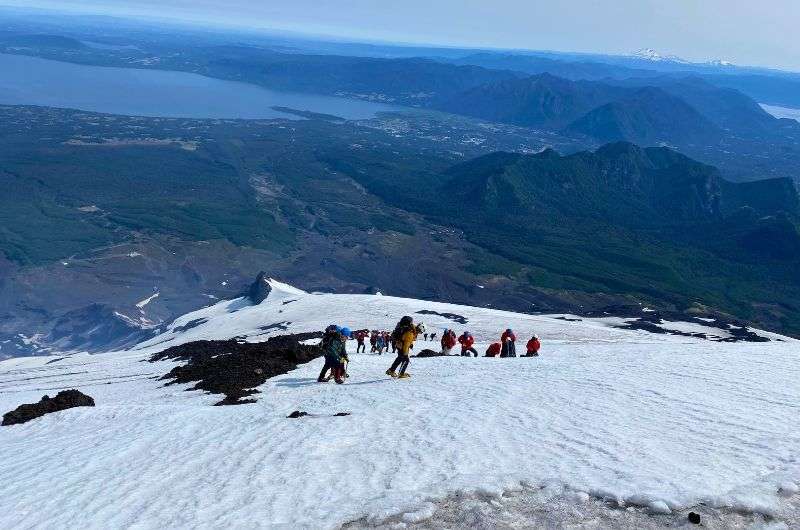
Choose the best guided tour to get the most out of your hike to Villarrica
Safety note: Most guided tours include more than one guide, usually assigning three guides to each tour group, typically with eight climbers. This isn’t just for show—it’s so everyone can get the attention they need. The guides are like a well-oiled machine, spreading out to help with everything from morale-boosting encouragement to catching you if you slip (hopefully).
Sometimes, all you need to do is take the first step... I've filtered out the best hotels near Villarrica for you
Save it for yourself to come back to later, or share with your friends on social media!
What to expect from the ski lift option
Most tours include the option of a ski lift that covers the first 400 m (1,300 ft) of elevation gain. It saves about 1.5 hours of uphill hiking through not-so-interesting terrain and spares your legs for the glacier ascent. I obviously took the ski lift because I knew that what follows was no walk in the park.
While it’s an extra cost (CLP 10,000 or USD 10), I highly recommend it unless you’re a purist who wants to conquer every step.
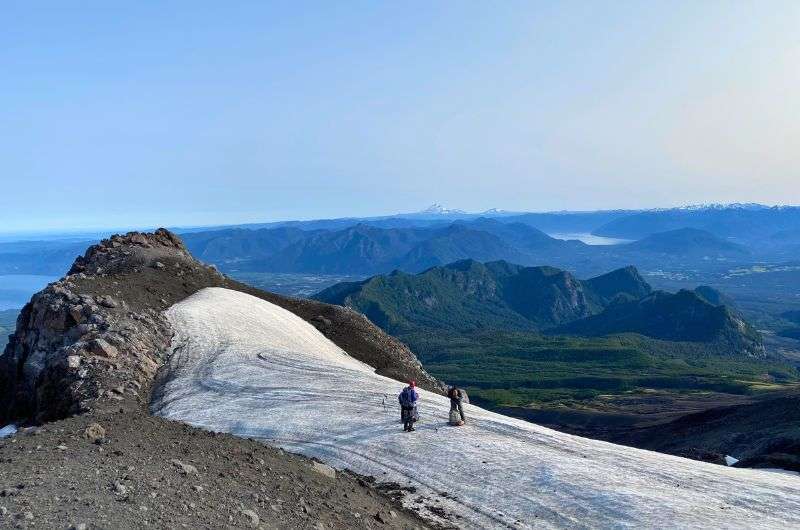
Using the cable car for the first part of the way to Villarrica Volcano is not cheating. Trust me, you’ll be happy you saved some energy
Is a guide mandatory for the Villarrica Volcano hike?
Yes, a guide is mandatory if you’re not an experienced climber. Chilean regulations require that you have proper certifications and equipment to climb Villarrica Volcano without a guide.
Attempting the climb without a guide is strongly discouraged and requires permits from CONAF (Chile’s National Forest Corporation), detailed documentation of your climbing skills, and the ability to communicate in Spanish to complete the process.
In short, for most people, joining a guided tour is the safest and easiest way to conquer Villarrica.

The last Villarrica Volcano eruption was in 2015
The last eruption occurred in 2015, an event that lit up the night sky with dramatic lava fountains visible for miles around. It was a spectacular reminder of the volcano’s raw power.
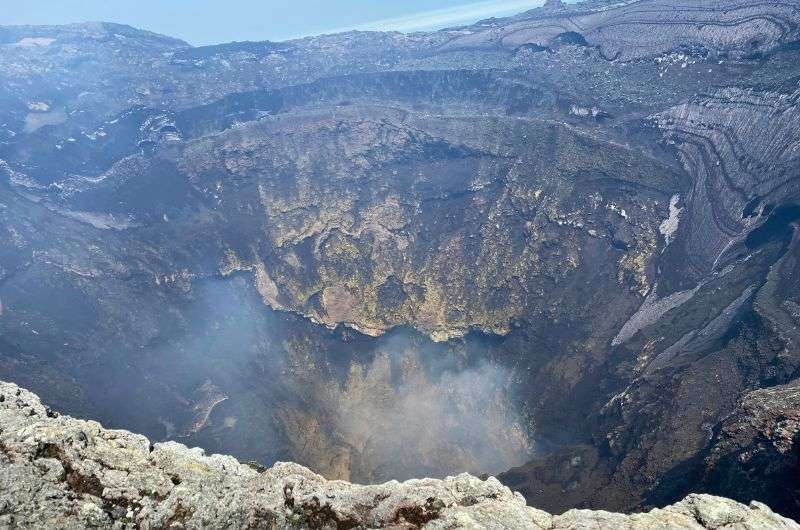
Last eruption was in 2015
The eruption forced the temporary closure of hiking routes and made Villarrica off-limits for several months. Nearby towns like Pucón were bustling with both curious tourists hoping for a glimpse of the fiery activity and locals evacuating as a precaution.
While the eruption caused disruptions, it also highlighted the importance of modern monitoring systems that now ensure ascents remain safe for visitors.
The Villarrica Volcano hike: My personal experience
1. The early morning start
The adventure began before sunrise—the kind of early that makes you question your life choices for a moment. At 6 am, we met our guide in Pucón, collected our gear (crampons, ice axe, helmet, gas mask—the whole dramatic ensemble), and boarded a van for the 30-minute drive to the base of the volcano.
In case I wasn't clear, this trek is very hard and you need to be psyched for it. The first discomfort starts with getting up really early. We had to be at our meeting point in front of the agency at 6 am, but I know some tours leave much earlier. Anyway, it's an interesting feeling being up this early and being ahead of a dangerous, steep, several-hour trek.
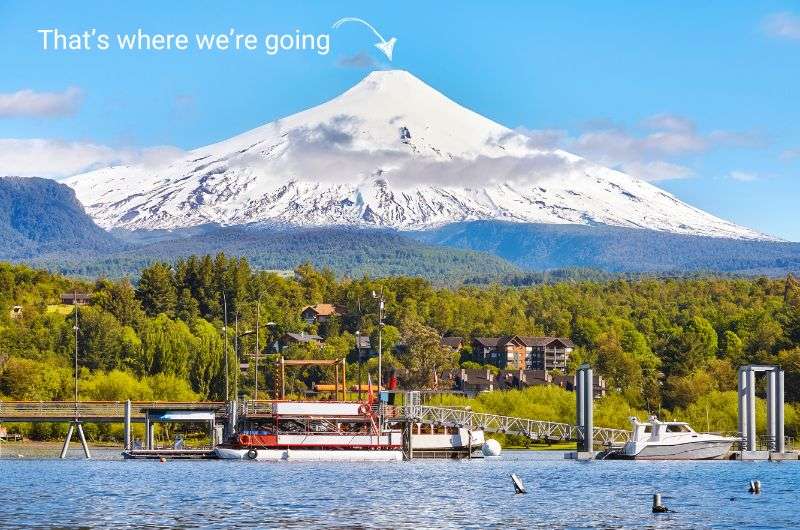
Yes, it looks challenging, and it’s not lying
Personal note: Packing sunscreen and sunglasses is crucial. Even in the early hours, the reflection off the snow can be brutal on your skin and eyes.
2. The ascent: A battle against the glacier’s slope
The hike starts on rocky trails but quickly transitions to snow and ice once you're off the ski lift. At around 1,500 m (4,900 ft), the crampons went on. You get used to walking in crampons pretty quickly, so don't worry if you've never tried them before.
The glacier was slippery, steep, and unforgiving. I’ll admit, I did more sliding than climbing at times, but thanks to our guide’s clear instructions on jamming the ice axe into the ice to stop a fall, I managed to avoid tumbling into oblivion—or worse, total embarrassment in front of the group.
The guide led us in a zigzag pattern to make the climb more manageable, and we followed them in single file to stay safe on the glacier's precarious surface. One of the guides stayed at the back, hanging out with the slower group (a.k.a., the people on the verge of crying) and offering much-needed pep talks. It was comforting to know there was always someone looking out for everyone, no matter their pace.
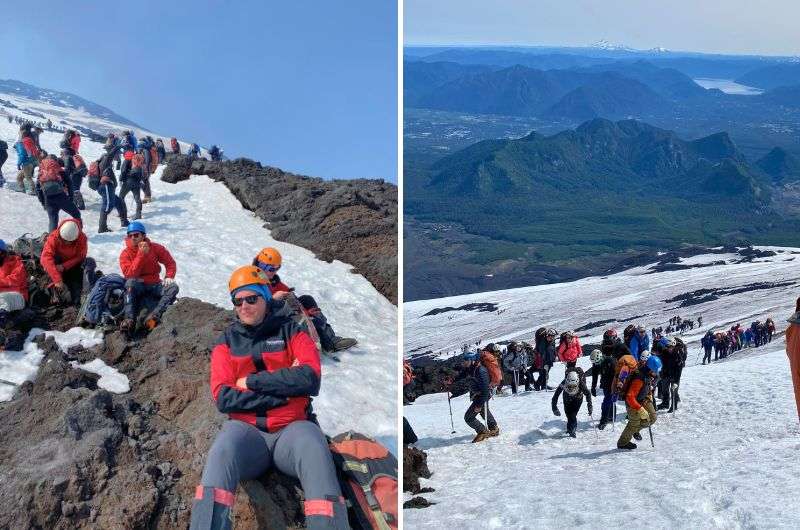
Trying to catch my breath
Anecdote: At one point, I slipped on the ice and slid a good 10 meters before remembering to slam my ice axe into the glacier. My heart raced, but the adrenaline was part of what made this adventure unforgettable. It's really mind-boggling how dangerous this hike is and people just go on it like it's nothing!
The climb was physically demanding, with a consistent 45-degree slope that made the final push to the summit feel like scaling a wall.
Thankfully, the occasional breaks were a lifesaver. We took four breaks in total, and the guides carried snacks to share with everyone—a much-needed treat to keep us going. While they had us covered, pack suggests adding your snacks that will give you an energy boost. That apple I brought along? Best apple I’ve ever had. It’s amazing how food tastes better when you’re on the edge of exhaustion!
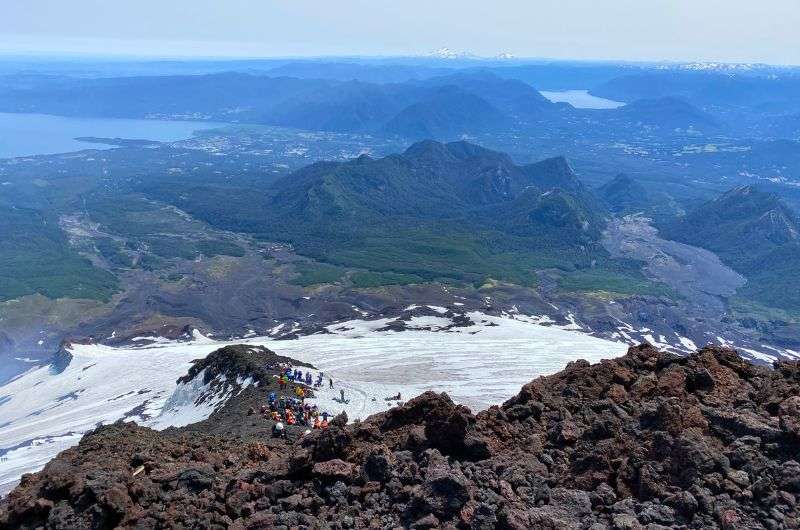
The views!
This part is HARD! The views, however, were worth every step. Snow-capped mountains stretched into the horizon, and the sense of isolation was both humbling and inspiring.
The sulfur challenge
As we approached the summit about 3 hours after we set off, the smell of sulfur grew stronger. Our guide instructed us to put on gas masks to protect our lungs from the fumes. It felt surreal—walking through a landscape of ice and rock with a gas mask on, knowing that molten lava churned beneath our feet.
3. Reaching the summit: Lava and views
Standing on the edge of Villarrica’s crater was like being on another planet. The temperature on top is significantly warmer than on the way there. It's around 60°C (140°F) on the caldera edge. You can even feel the heat coming up through the ground under your feet.
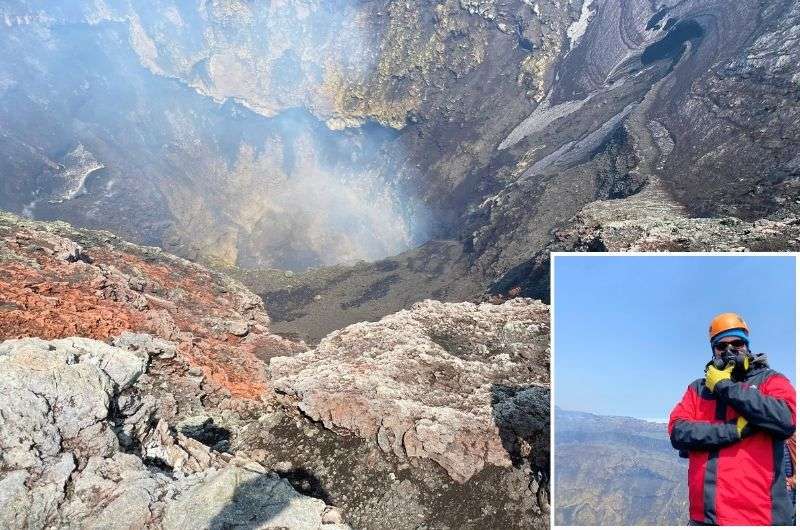
I made it!
On the other hand, it’s also extremely windy up by the crater. Like, no gentle breeze—we’re talking the wind that would carry an adult cow away. Peering into the crater, I saw the faint glow of lava and felt a mix of awe and respect for the raw power of nature.
Climbing our way through the glacier, standing on top of the volcano, and taking in the views was perhaps the top experience in Chile, and certainly the highlight of the Chilean Lake District. The heat of the moment is beyond words.

Pro tip: The summit can be surprisingly warm due to the volcanic heat, so you may want to shed a layer before reaching the top. But hold onto everything tightly—the wind doesn’t forgive mistakes.
The panoramic views from the summit were breathtaking. On clear days, you can see the Andes Mountains stretching to Argentina and a chain of other volcanic peaks dotting the landscape.
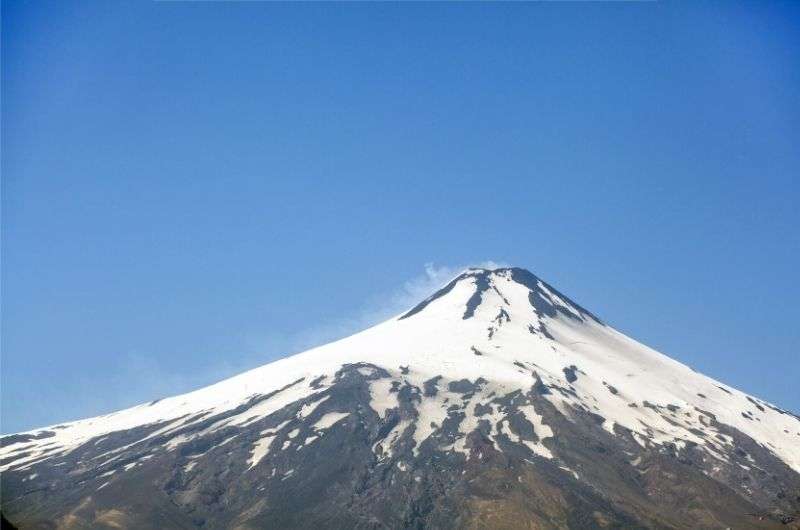
It's kind of unbelievable that I was all the way up there
4. The descent: Tobogganing down the volcano!
After the grueling climb, the descent was pure joy and completely unexpected. Felipe, our guide, handed each of us a small plastic toboggan and instructed us to sit on it. You could see the mix of nervous and excited laughter on everyone’s faces!
But don’t worry, you’ll get the hang of sledding in no time. While sliding down volcán Villarrica, I (almost) completely forgot how tough the climb had been. Swooshing down icy chutes at exhilarating speeds felt like the ultimate reward for the morning’s effort.
Personal note: Be sure to follow your guide’s instructions on how to steer and stop! I found myself gripping the edges of the plastic toboggan so tightly my knuckles turned white, yet I couldn’t help laughing all the way down. Take it slow if you’re nervous, pack some courage, and enjoy every heart-pounding second of this wild descent.
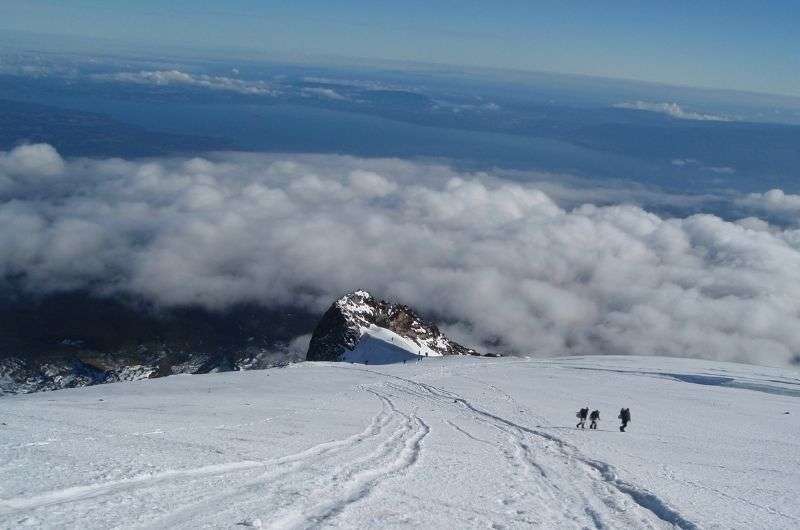
And down we went on plastic sleds!
5. The aftermath: Give your legs a break!
After this thrilling “Fast and Furious: Kindergarten Edition” experience, we decided to reward ourselves with massages and hot springs baths in Termas Geometricas. No kidding, soaking in the hot springs amidst the forests and cliffs was the best possible decision (I think I heard my muscles praising me the next day).
Where to next?
See my 3-week Chile itinerary for a complete trip plan for a fun, adventurous Chile vacation! Otherwise, check out the other top things to do in Pucon and the Lake District, or move further south to Torres del Paine in Patagonia. Chile has so many spectacular natural highlights you’ll never be bored.
Sometimes, all you need to do is take the first step... I've filtered out the best hotels near Villarrica for you
Save it for yourself to come back to later, or share with your friends on social media!
This post contains affiliate links. I earn a small commission if you make bookings through my links, at no additional cost to you. Thank you for your support!




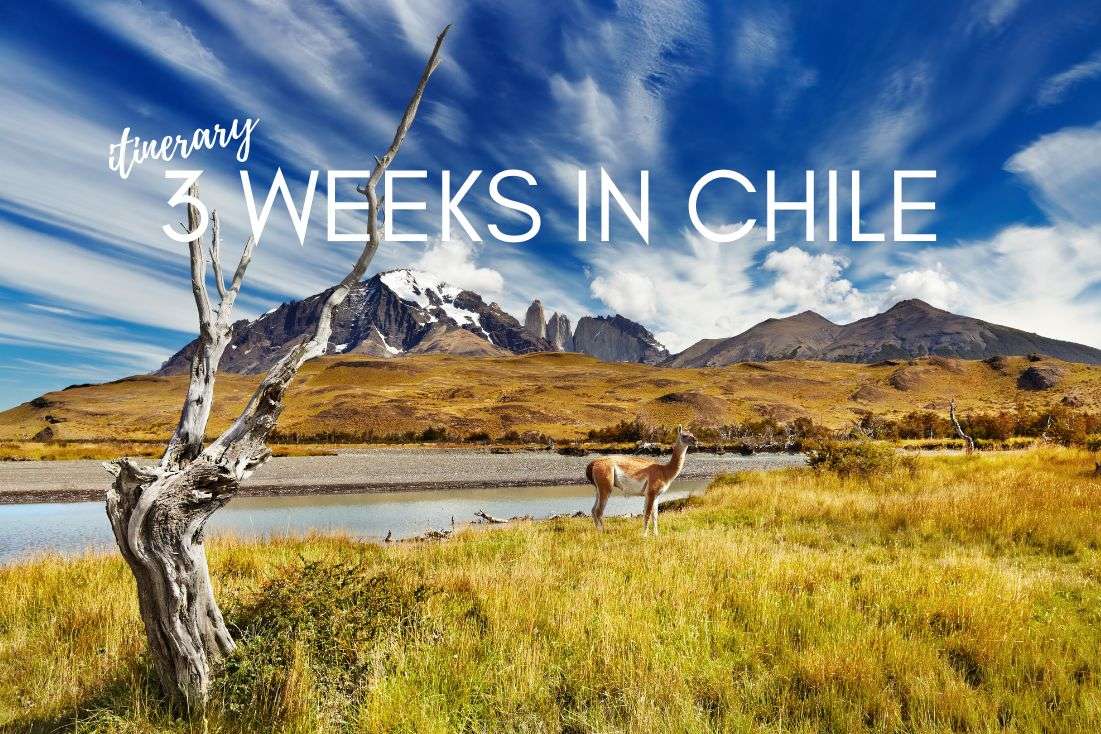
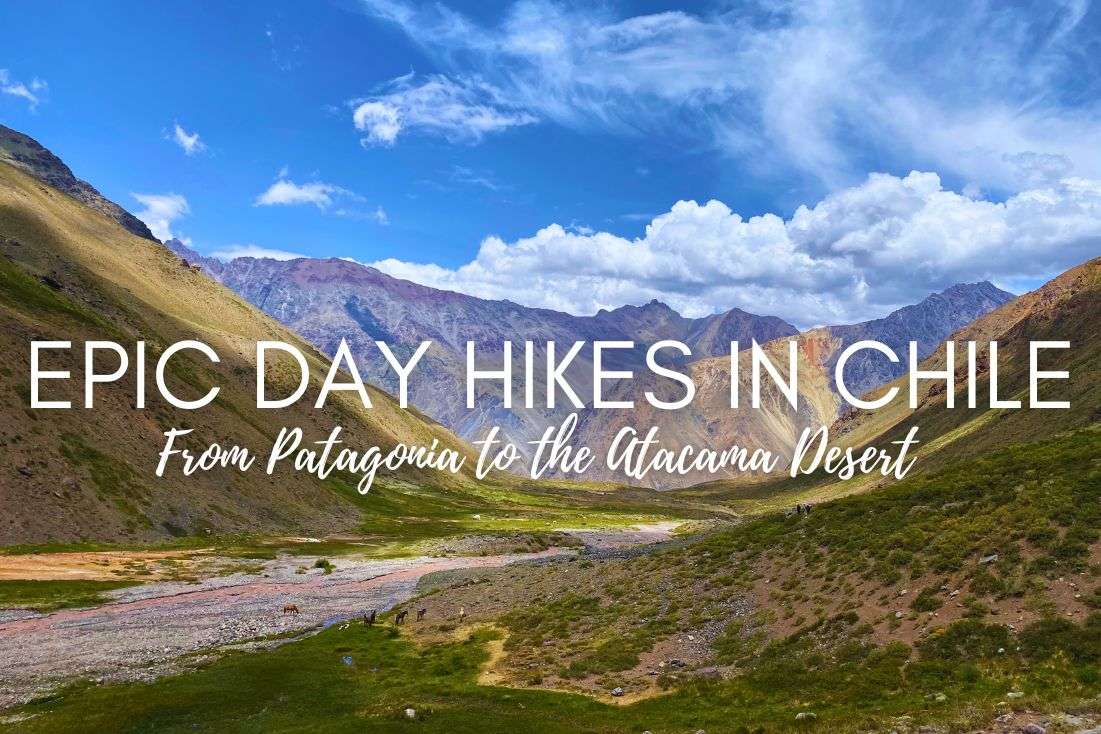
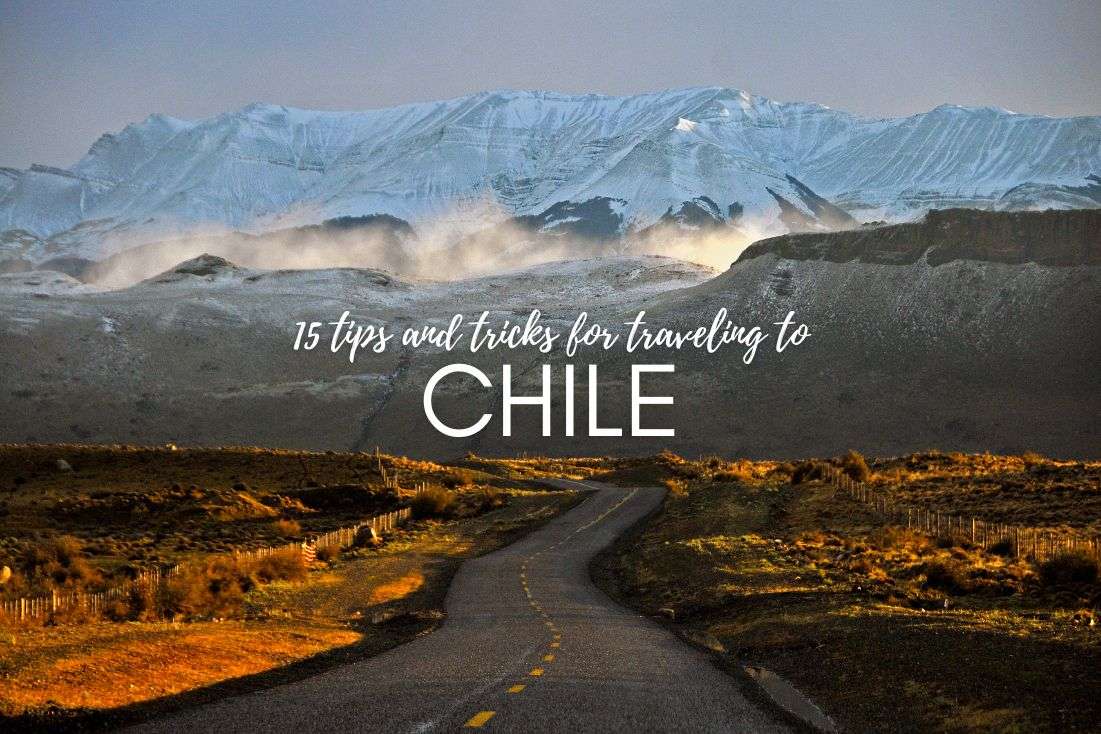



Comments | Thoughts? Give us a shout!